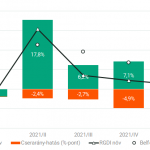Since 2011, a wide range of unhealthy food and drink are subject to a specific excise tax in Hungary. We analyze how this tax affected the revenue, sales volume, personnel costs, and size of sweet food producers, and compare these results to estimated effects on household spending on sugary food. We base our analysis on administrative data sets of firm level indicators, and survey data on household spending. We apply the estimation method of difference-in-differences, where firms producing untaxed processed food (in the firm level analysis) and household spending on food categories directly not affected by the tax (in the household level analysis) serve as control groups. Our results suggest strong negative short-run effects of the unhealthy food tax on firms’ inland sales volume, and moderate effects on inland sales revenue and personnel costs. These results correspond to the moderate estimated effects on household spending on sugary food. The reducing effects diminish in about 3 years after the introduction of the tax—overlapping with the recovery of the Hungarian economy from recession. Our findings suggest that the impacts of an unhealthy food tax strongly depend on the economic conditions.
Nem található esemény a közeljövőben.
A KRTK Közgazdaság-tudományi Intézet teljesítményéről A KRTK KTI a RePEc/IDEAS rangsorában, amely a világ közgazdaság-tudományi tanszékeit és intézeteit rangsorolja publikációs teljesítményük alapján, a legjobb ... Read More »

Tisztelt Kollégák! Tudományos kutatóként, intézeti vezetőként egész életünkben a kutatói szabadság és felelősség elve vezetett bennünket. Meggyőződésünk, hogy a tudomány csak akkor érhet el ... Read More »

Srí Lanka: a 2022-es gazdasági válság leckéje – A. Krueger Lessons from Sri Lanka Anne O. Krueger Jul 25, 2022 – Project Syndicate ... Read More »

A permanens válság korában élünk – J. Meadway We’re living in an age of permanent crisis – let’s stop planning for a ‘return ... Read More »

A 2021 végén, illetve 2022 elején tapaszalt 6, illetve 7%-os cserearányromlás brutális reáljövedelem-kivonást jelentett a magyar gazdaságból. A külső egyensúly alakulásával foglalkozó elemzések többnyire ... Read More »
